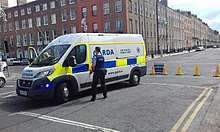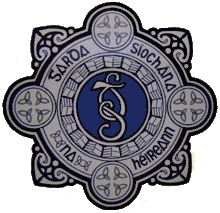Garda Traffic Corps

The Garda National Roads Policing Bureau (GNRPB) (Irish: Póilínú Bóithre) is the roads policing unit of the Garda Síochána. Prior to 2018, it was known as the Garda Traffic Corps.[1][2][3]
Duties
The GNRPB's[4] main responsibility is to improve road safety and significantly reduce the incidences of fatal and serious injuries on Irish roads. A Traffic Corps unit was first established in Dublin in 1953. Each Garda Division now has a Roads Policing Unit of its own.
Organization
A Roads Policing Unit exists across every Division of An Garda Síochána, with an additional regional unit assigned to the Dublin Metropolitan Region. Divisions located in border areas such as the Donegal Division, operating from Letterkenny Divisional Headquarters, receive a lot of presence. Due to the close proximity of the border with Derry there is an increased chance of vehicles failing to stop, often resulting in high-speed chases. In such cases the Gardaí aim to stop vehicles before they reach the border and work closely with the Police Service of Northern Ireland to combat border-driving.
Dublin Metropolitan Region
The DMR Roads Policing Unit was the first dedicated traffic unit, established in 1953. It is headed by a Chief Superintendent and supported by 2 Superintendents, 2 Inspectors, 15 Sergeants, 101 Gardaí operating from a facility at Dublin Castle.[5] This unit supports all Divisional Roads Policing Units within the Dublin Metropolitan area as well as conducting checkpoints and patrol of the entire duration of the M50 motorway.
Programs
In 2006, the Traffic Corps in every county in Ireland researched fatal, serious injury, and minor injury collision history that had occurred during the previous 10 years on the primary and secondary roads within each county. All the roads were divided into 5 to 8 mile zones and given an identity incorporating the national route number. Calculations were done on the collision history within each zone and as a result of this the zones were colour coded red amber and green. Red denoting the zones where most collisions occurred. Traffic Corps patrolling was then targeted giving priority to the red zones, then the amber zones and so on. This led to a year on year reduction of fatal collisions on Irish roads until 2012 when road deaths began to rise again. These zones were called Collision Prone Zones ( CPZ ) a list of which was published on the Garda website. This list was subsequently replaced by a list of speed enforcement zones used by the operators of speed detection vans. The rise in road fatalities seems to have occurred at the same time as the number of Gardaí working in the Traffic Corps was reduced and the number of vehicles available to the Traffic Corps was also reduced.
Vehicles
Garda Roads Policing Units use a range of vehicles, including motorcycles, marked and unmarked cars and 4x4 vehicles. Marked Roads Policing Unit vehicles are visibly different from standard Garda vehicles in that they feature the words "Roads Policing" and it's Irish translation, "Póilínú Bóithre", along with full-coverage high visibility blue and yellow Battenburg markings.
Cars
The main Roads Policing vehicle is the Hyundai i40 Tourer, with a smaller number of Toyota Avensis, Opel Insignia Estates and Hyundai i30 Tourers in service. The BMW 530D is slowly being rolled out in small numbers with a focus on rural areas, in response to rural burglary gangs using high-powered vehicles.
A number of Hyundai i40 and older Ford Mondeo saloons are used as unmarked vehicles in certain units.
SUVs
The Mitsubishi Pajero and Ford Ranger currently serve as the main 4x4s, frequently used for motorway patrol.
The DMR Roads Policing Unit operates a four-door Isuzu D-Max as a motorway support vehicle, equipped with a utility shell for carrying traffic control and collision reconstruction and investigation equipment.
Vans
Pearse Street Divisional Roads Policing Unit is equipped with a Fiat Ducato van for transporting cones.

The Dublin Metropolitan Region Roads Policing Unit also operates a single marked Ford Transit automatic speed limit enforcement photo radar van.
Motorcycles
A number of motorcycles were purchased in 2011 - these were Honda Deauville 700cc and not the Yamaha FJR 1300cc which was the previous Traffic motorcycle.
Former vehicles
Formerly, the Ford Mondeo served as the standard patrol vehicle, in both marked and unmarked variants, with the Isuzu Trooper and later the Toyota Land Cruiser serving as the standard 4x4 vehicles.

Automatic Number Plate Recognition
Automatic number-plate recognition was introduced for use by the Traffic Corps in 2009, with about 40% of the Traffic Corps vehicles being fitted with ANPR systems.
Media
Traffic Blues is a documentary series broadcast on RTÉ One. It follows various traffic officers from the Garda Síochána.[6]
References
- ↑ "Garda Traffic Corps set to be replaced by unit with wider remit". Irish Times. Retrieved 1 May 2018.
- ↑ "Press Releases - May 2018 - 87 new Garda Members appointed to Roads Policing Units throughout the country". Garda.ie. Retrieved 1 May 2018.
- ↑ "Garda National Roads Policing Bureau Homepage". Garda.ie. Retrieved 1 May 2018.
- ↑ "The Traffic Corps". Garda Síochána. 2009. Archived from the original on 23 August 2010. Retrieved 2009-10-15.
- ↑ "Traffic Corps - Dublin Metropolitan Region". Garda.ie. Archived from the original on 2 March 2011.
- ↑ "IFTN Press Release". Retrieved 2009-06-02.
